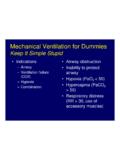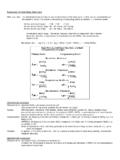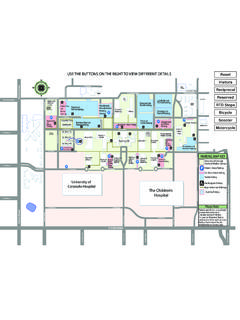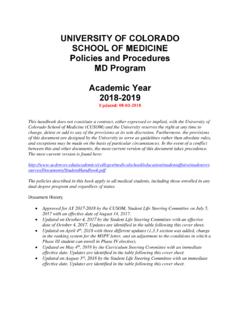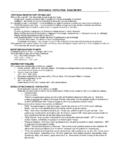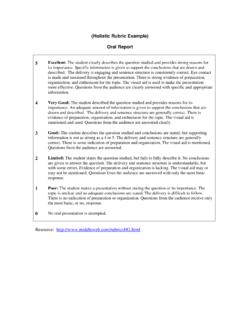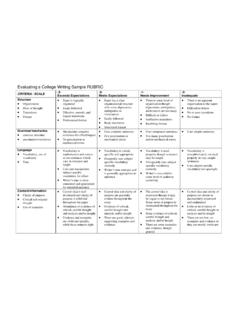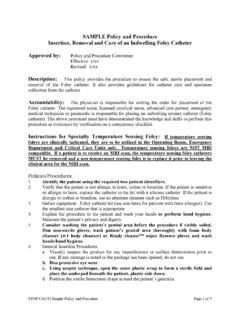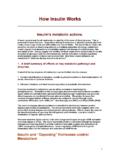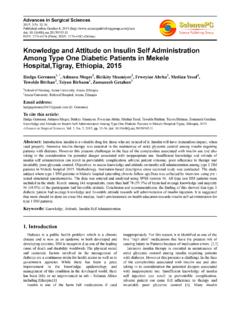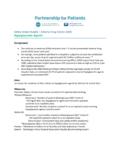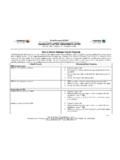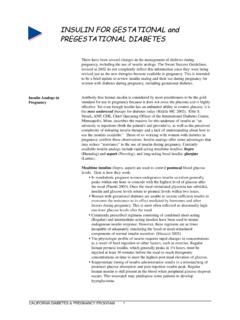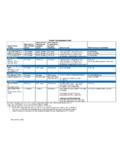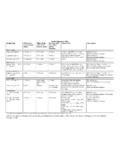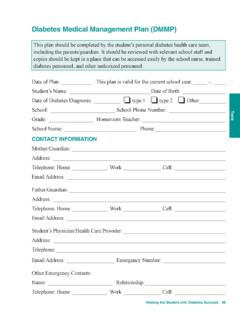Transcription of Chapter 8 Insulin: Types - Denver, Colorado
1 TOPICS:Medications( insulin )TEACHING OBJECTIVES: 1. Describe insulin and what itdoes in the Present the Types of insulins tobe used and their Discuss the schedule for Identify who and when to callfor insulin OBJECTIVES:Learners (parents, child, relative orself) will be able to:1. State why the body List the specific Types ofinsulins to be used and theiractions (onset, peak andduration). the schedule for insulininjections (including before orafter meals). who and when to callfor insulin 8 insulin : T ypesand Activit yH. Peter Chase, MDSatish Garg, MDINSULINB efore insulin was discovered in 1921, there was little helpfor people who had type 1 diabetes. Since then, millions ofpeople all over the world have been helped by is a hormone made in the pancreas, an organ insidethe abdomen (see picture in Chapter 2).
2 Special cells called beta cells make the insulin . These cells are located in a partof the pancreas called the islets (pronounced eye-lets). Whena person has type 1 diabetes, there is a loss of the cells whichmake insulin . Most people with diabetes now use humaninsulin or insulin analogs. The human insulin does not comefrom humans, but has the same make-up as human is produced by bacteria (Lilly) or by yeast (Novo-Nordisk)using genetic engineering. There are no known advantagesof one brand of insulin over another brand. The analoginsulins have slight changes that make their activity resemblenormal insulin DOES insulin DO?Food (carbohydrate) is converted to sugar for the body senergy needs. The insulin allows the sugar to pass from theblood into the cells. There it is burned for energy.
3 The bodycannot turn sugar into energy without insulin (see diagram inChapter 2). insulin also turns off the making of sugar in theliver (see Chapter 2). If insulin is not available, the sugar buildsup in the blood and spills into the 8 insulin : Types and ActivityPeople who have type 1 diabetes can t makeenough insulin . These people have to get theneeded insulin through injections. Insulincannot be taken as a pill, because thestomach acid destroys it. There are no knownvitamins, herbs or other medications which cantake the place of insulin injections. People whohave type 2 diabetes still make insulin (althoughnot enough to keep their sugars in a normalrange, see Chapter 4). They can take pills tohelp them make even more insulin or to bemore sensitive to their own insulin .
4 However,these pills are notinsulin. Types OF INSULINS everal companies make many differenttypes of insulins. The three broad classes of insulin are:1. rapid-acting (such as Humalog [H],NovoLog [NL], Apidra [AP]) and Regular (R)2. intermediate-acting (such as NPH [N])3. long-acting such as Lantus (insulinglargine) and Levemir ( insulin detemir) insulin action (when it begins working, whenit peaks in activity and how long it lasts) may varyfrom person to person. The action may also varyfrom one day to the next in the same site of the shot and exercise may influencethe insulin action. Increased temperature (bath,shower, hot tub, sauna) may increase bloodsupply to the skin and cause the insulin to beabsorbed more rapidly. Average times of actionfor different insulins are shown in Table Rapid-Acting Insulins and RegularInsulinHumalog/NovoLog or Apidra (H, NL orAP) insulins are rapid in onset of activity (10-15minutes).
5 They have a peak activity in 30-90minutes and effectively last three to four figures show the activities of the rapid-acting insulins. All are similar in activity. Wemay use the term rapid-acting insulin toindicate that the insulin used may be any one ofthe three (H, NL or AP). Regular insulin begins to act approximately30-60 minutes after being injected. It has itspeak effect two to four hours after the injectionand lasts six to nine hours. There is again,considerable variability in these times fromperson to (H/NL/AP)insulins have several advantages overRegular Insulin: They start to work in 10-20 minutes ratherthan in 30-60 minutes. It is best to take thepremeal insulin 10-15 minutes before eating(see Table 3 in Chapter 9). If given beforethe meal, they peak in activity as the carbsare turned into blood sugar.
6 On the otherhand, Regular insulin peaks after the food ismostly absorbed and is more likely to causelow blood sugars!The blood sugar levels two hours after mealsare lower when a rapid-acting insulin istaken 10-15 minutes prior to the rapid-acting insulin does notlast as long as Regular insulin , there is lessdanger of lows during the night when takenat of rapid-acting insulin after meals intoddlers who eat varying amounts can helpto prevent hypoglycemia as well as foodstruggles ( Chapter 18).It is important to remember to avoid takinga warm shower (or bath) or getting into a hottub for one to two hours after taking warm water increases the blood flow to theskin and causes the insulin to be absorbedfaster. This faster rate of absorption could causea low blood Intermediate-acting insulins (last 10-20 hours)4 NPH (N) insulin is made with a protein thatallows it to be absorbed in the body moreslowly.
7 The letters NPH stand for NeutralProtamine Hagedorn. Protamine is theprotein added to the insulin to make itChapter 8 insulin : Types and Activity67longer-acting (also referred to as cloudy insulin ). Hagedorn is the name of the manwho developed it. Human NPH has its peakactivity four to eight hours after the injectionin most people. If it is taken in the morning,the peak action comes before NPH insulin lasts an average of 13hours. The peak in NPH insulin activity andthe duration of activity may vary for somepeople. NPH insulin may be premixed withRegular insulin without changing theactivities of either insulin . (NPH is nowcalled N on the bottles.)4 Pre-mixed Insulins: The pre-mixedinsulins are used primarily by people who donot wish to draw the insulins from separatevials prior to injecting.
8 They have thedisadvantage that the percentage of eachinsulin is fixed and the individual insulinscannot be varied (for variations in bloodsugar, exercise, food, illness, etc.). Thereare many mixtures available and only twoexamples will be and Mixtard ;differentcombinations of pre-mixed NPH andRegular insulin are available. The mostfrequently used are 70/30 and Mixtard,both of which have 70 percent NPH and30 percent Regular insulins. The usualtimes of activity are shown in Table mix 75/25 (Lilly) is also acombination of a rapid (25 percent) andan intermediate-acting (75 percent) insulin . The rapid-acting portion is a bit blunted when compared with theusual Humalog peak. Some peoplerequire a third injection of 75/25 atlunch or bedtime for better Long-acting insulin (lasts 20-24 hours)4 Lantus ( insulin Glargine) insulin becamereadily available in the in May, is a clear insulin that lasts 24 hours withalmost no peak (the first true basal insulin ).
9 Its profile is similar to the basal insulin (theinsulin that stops sugar output from theliver) put out by a normal pancreas. It isoften compared with the basal insulin of aninsulin pump ( Chapter 26).4 insulin detemir (Levemir; made by Novo-Nordisk) is also being used as a basalinsulin. Its duration is up to 24 hours, butit may need to be taken twice daily for somepeople. Levemir was approved by the FDAfor use in adults in June, 2005, and for usein children in October, 2005. It is a clearinsulin but cannot be mixed with a rapid-acting insulin . As of this writing, we havenot had experience in using of Lantus (and presumably ofLevemir)Its consistency in absorption and activitymake it more predictable. NPH varies in itspeak activity even in the same person from oneday to the next.
10 Lantus insulin has lessvariability and does not have a peak (unless it isaccidentally injected into the muscle).lBecause it is a clear insulin , it does not needto be turned up and down to mix. There isno settling in the vial and insulinconcentrations do not vary from one shot tothe of low blood sugars. Initialstudies at our Center have shown a decreasein very low blood sugars, particularly duringthe night, when compared with using NPHinsulin. This is due to less of an activitypeak as well as consistent of Lantus (and presumably ofLevemir)lWhen using Lantus, three or more shots perday of insulin may be it is clear and has a purple cap, caremust be taken not to confuse it with therapid-acting insulins, which are also directions state that it may not bemixed with other insulins.
